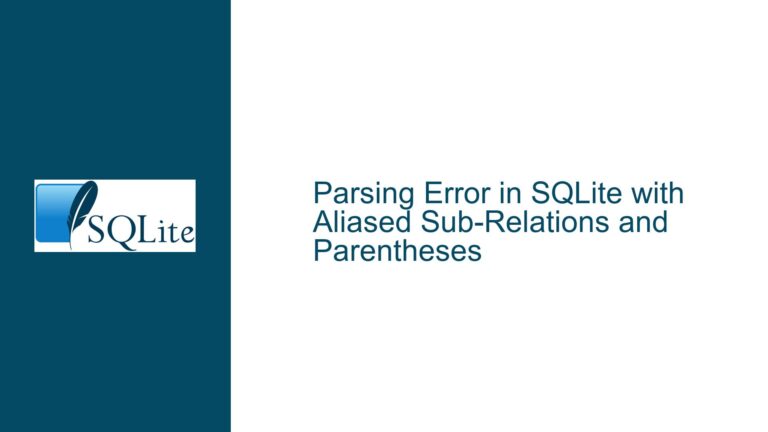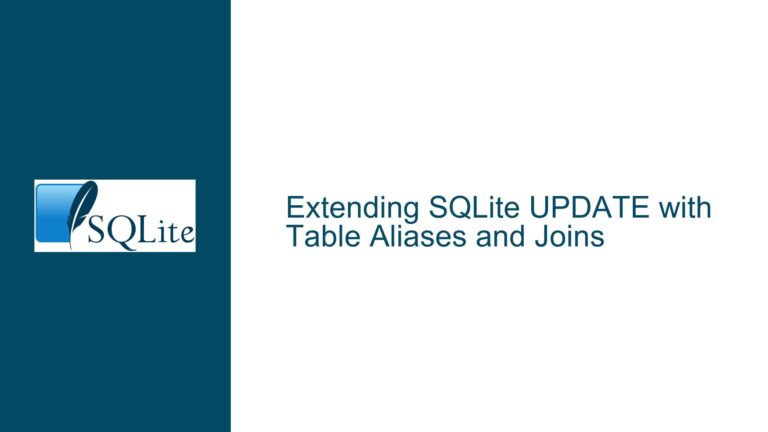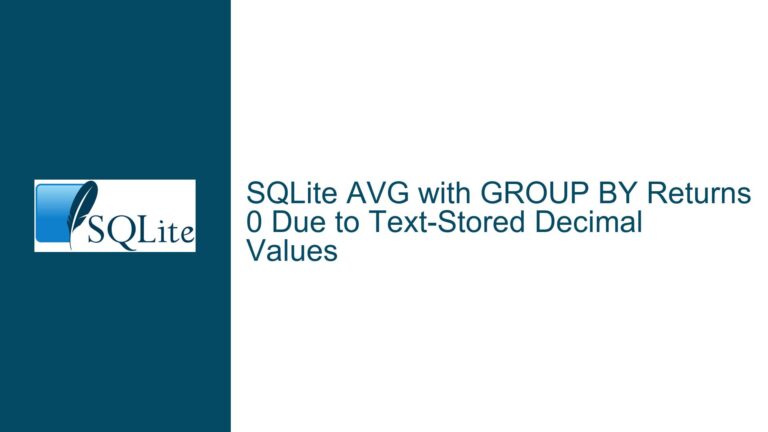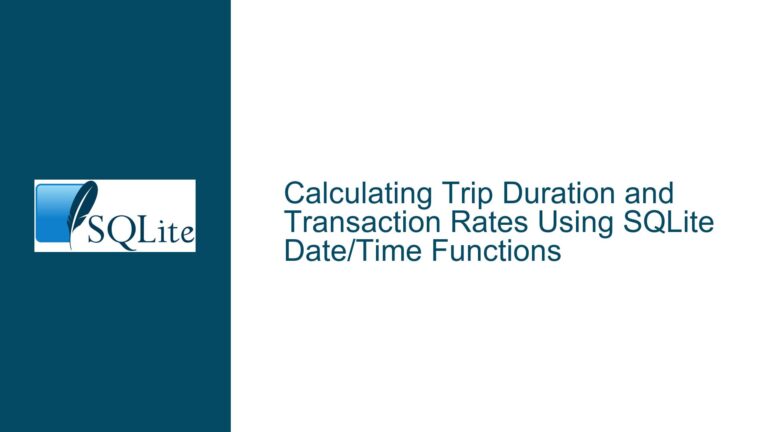Resolving NullReferenceException in SQLite During .NET Unit Tests
Diagnosing Intermittent NullReferenceException in SQLite Data Access Layer
The NullReferenceException (NRE) occurring within SQLite operations during .NET unit tests manifests as a system-level error originating from the sqlite3_step native method. The exception stack trace indicates a failure during query execution when attempting to iterate through result sets via SQLiteDataReader. This error exhibits non-deterministic behavior across test runs, with failures occurring in different tests despite enforced test serialization. Key contextual factors include:
- Use of uniquely named encrypted databases per test via SQLite Encryption Extension (SEE)
- Database lifecycle limited to individual test execution (create → query → delete)
- System.Data.SQLite NuGet package v1.0.116
- Exception correlation with SEE initialization (failures disappear when disabling encryption)
The critical path through the stack trace reveals failure at the boundary between managed .NET code and native SQLite library during result set processing. This suggests either invalid state propagation in the ADO.NET layer or corruption of native SQLite structures before/during query execution. The encryption dependency pattern (failure disappears without SEE) further narrows the fault domain to cryptographic initialization sequences or resource contention in encrypted database handling.
Root Cause Candidates: Connection Lifecycle, Cryptographic Initialization, and Resource Contention
1. Improper Connection/Command Lifecycle Management with SEE
SQLite connections requiring encryption must establish cryptographic parameters immediately after opening. If SEE configuration (password setting, page size alignment) occurs after command preparation or concurrent with active transactions, the native SQLite engine may reference uninitialized structures during sqlite3_step execution. This is exacerbated when connection pooling or statement caching interacts with per-test database uniqueness – a scenario where connection reuse assumptions break down.
2. Race Conditions in Encrypted Database File Operations
The test pattern (create → use → delete encrypted DB) introduces file I/O synchronization challenges. Anti-virus software, disk encryption drivers, or .NET garbage collection timing might temporarily retain file locks after explicit SQLiteConnection.Close(), causing partial file deletion. Subsequent tests attempting to create same-named databases before full filesystem cleanup would collide with residual artifacts, particularly problematic with SEE where incomplete database headers fail key derivation.
3. Improper Thread Affinity of SEE-Enabled Connections
While tests run serially, .NET asynchronous patterns or task schedulers might dispatch connection cleanup/disposal to different thread contexts. SQLite’s threading mode configuration (SERIALIZED vs MULTI_THREAD) combined with SEE’s internal cryptographic locks could create null reference scenarios if native resources are accessed across thread boundaries despite apparent single-threaded usage.
4. SEE Extension Loading Timing Issues
Mixed-mode assembly resolution in .NET might delay SEE component initialization until first cryptographic operation, creating a race condition where early SQLite API calls execute before native SEE hooks are fully operational. This would leave critical data structures like sqlite3_stmt pointers uninitialized when encryption is required but not yet configured.
Resolution Strategy: Validating Encrypted Connection Workflows and Resource Isolation
Step 1: Enforce Atomic SEE Configuration Per Connection
Wrap all encrypted database creation in a deterministic initialization sequence:
using (var conn = new SQLiteConnection($"Data Source={path};Version=3;"))
{
conn.Open();
conn.ExecuteNonQuery($"PRAGMA key='{key}';"); // Immediate SEE activation
conn.ExecuteNonQuery($"PRAGMA cipher_page_size=4096;"); // SEE-specific
// Proceed with schema initialization
}
Validate that no commands execute before setting the encryption key. Use SQLiteConnection’s StateChange event to log actual open timing versus first command execution.
Step 2: Implement Diagnostic File Lock Monitoring
Insert cross-platform file lock checks before database deletion:
public static void DeleteDatabase(string path)
{
for (int i = 0; i < 10; i++)
{
try
{
if (File.Exists(path)) File.Delete(path);
break;
}
catch (IOException) when (i < 9)
{
var processes = GetFileLockingProcesses(path); // Implement via syscall
Log($"File locked by {processes}");
Thread.Sleep(100);
}
}
}
Combine with SQLiteConnection.ClearAllPools() and GC.Collect() before deletion to force finalization of dangling connections.
Step 3: Configure Strict Thread Affinity for SQLite Connections
Decorate all test methods with [STASequential] attributes to enforce single-threaded execution context, even when underlying test runners use thread pools:
[Test]
[Apartment(ApartmentState.STA)]
public void EncryptedQueryTest()
{
// Test logic
}
Augment connection strings with Pooling=False; to prevent background thread interactions through connection pooling.
Step 4: Validate Native SEE Binding Integrity
Inject early-stage cryptographic self-tests before any database operations:
[TestInitialize]
public void ValidateSeeBindings()
{
using (var conn = new SQLiteConnection("Data Source=:memory:;Version=3;"))
{
conn.Open();
conn.ExecuteNonQuery("PRAGMA key='test';");
conn.ExecuteNonQuery("CREATE TABLE t(x);");
conn.ExecuteNonQuery("INSERT INTO t VALUES (hex(randomblob(16)));");
var value = conn.ExecuteScalar<string>("SELECT x FROM t LIMIT 1;");
Assert.IsTrue(value?.Length == 32);
}
}
This smoke test verifies SEE functionality before test-specific databases are created.
Step 5: Instrument SQLite Native Interop Layer
Modify System.Data.SQLite internals (via decompilation/rebuilding) to log native handle states:
// In SQLite3.Step()
IntPtr stmt = GetStatementPtr();
Log($"Step called on stmt 0x{stmt.ToInt64():X8}");
if (stmt == IntPtr.Zero)
throw new InvalidOperationException("Null statement");
Distribute the instrumented binary to capture exact state during NRE occurrence.
Step 6: Enforce Full Finalization of Prepared Statements
Wrap all SQLiteDataReader usage in strict disposal blocks and validate statement finalization:
using (var cmd = new SQLiteCommand(conn))
{
cmd.CommandText = "SELECT ...";
using (var reader = cmd.ExecuteReader())
{
while (reader.Read()) { ... }
} // Ensures reader.Close() called
// Additional cmd.Dispose() redundant but safe
}
Augment with runtime checks using PRAGMA compile_options; to confirm SQLITE_OMIT_DEPRECATED isn’t set, which could alter statement finalization semantics.
Step 7: Update SQLite Engine with Enhanced Diagnostics
Replace the System.Data.SQLite NuGet package with a custom build containing SQLite’s debugging extensions:
export CFLAGS="-DSQLITE_DEBUG=1 -DSQLITE_ENABLE_NORMALIZE=1"
./configure --enable-debug --enable-rtree --enable-json1 --enable-fts5
make
Embed the compiled sqlite3.o into the .NET provider to enable detailed statement normalization logs and corruption diagnostics.
Step 8: Implement Cross-Process File Handle Audit
Utilize sysinternals handle.exe or lsof during test execution to detect external processes locking database files:
while ($true) {
handle64.exe -nobanner test.db | Out-Host
Start-Sleep -Milliseconds 500
}
Correlate lock events with test phase (creation vs deletion) to identify third-party interference.
Step 9: Cryptographic Initialization Verification
Enable SQLite’s internal encryption status reporting through undocumented pragmas:
conn.ExecuteNonQuery("PRAGMA cipher_status;");
Parse output to confirm key derivation completion and page encryption mode before executing test queries.
Step 10: Memory-Mapped I/O Configuration
Experiment with disabling memory-mapped I/O for encrypted databases to eliminate shared cache conflicts:
conn.ExecuteNonQuery("PRAGMA mmap_size=0;");
Combine with SQLITE_CONFIG_MMAP_SIZE=0 during native initialization to fully disable memory mapping.
Step 11: Validate SEE-Compatible Page Size Configuration
Ensure database page size matches SEE requirements through explicit pragma:
conn.ExecuteNonQuery("PRAGMA cipher_page_size=4096;");
conn.ExecuteNonQuery("PRAGMA page_size=4096;");
Verify that page_size matches cipher_page_size after vacuum operations through PRAGMA page_size;.
Step 12: Forced GC and Finalization Before Database Deletion
Modify test teardown logic to aggressively clean up managed and native resources:
[TestCleanup]
public void Cleanup()
{
conn.Dispose();
SQLiteConnection.ClearAllPools();
GC.Collect();
GC.WaitForPendingFinalizers();
DeleteDatabase();
}
This nuclear approach eliminates lingering sqlite3 objects holding file handles.
Step 13: Native Heap Analysis via SQLite’s Memory Statistics
Enable detailed memory tracking to detect buffer overflows or double-free errors:
conn.ExecuteNonQuery("PRAGMA memory_status;");
conn.ExecuteNonQuery("PRAGMA soft_heap_limit=1048576;");
Compare memory metrics between successful and failed test runs to identify allocation anomalies.
Step 14: Cross-Platform File System Sync Enforcement
Disable write caching on database files to ensure metadata synchronization:
conn.ExecuteNonQuery("PRAGMA synchronous=FULL;");
conn.ExecuteNonQuery("PRAGMA temp_store=MEMORY;");
Combine with FileStream flushing using FileOptions.WriteThrough when creating database files.
Step 15: SEE Version Compatibility Verification
Query the native SQLite version bound to System.Data.SQLite:
var version = conn.ExecuteScalar<string>("SELECT sqlite_version();");
var seeVersion = conn.ExecuteScalar<string>("SELECT sqlite_see_version();");
Confirm SEE compatibility with the underlying SQLite version through official release notes.
Final Validation Protocol
After implementing diagnostic measures, execute tests under the following conditions to isolate variables:
- SEE enabled with full diagnostics
- SEE disabled
- In-memory databases instead of file-based
- Different .NET runtime versions
- Windows vs Linux test hosts
Cross-reference stack traces and SQLite internal logs to identify cryptographic initialization gaps or thread affinity violations. The non-deterministic nature of failures demands statistical analysis across hundreds of test runs with instrumentation active. Permanent resolution may require upgrading System.Data.SQLite to versions with improved SEE lifecycle management or migrating to Microsoft.Data.Sqlite with modern encryption providers.






